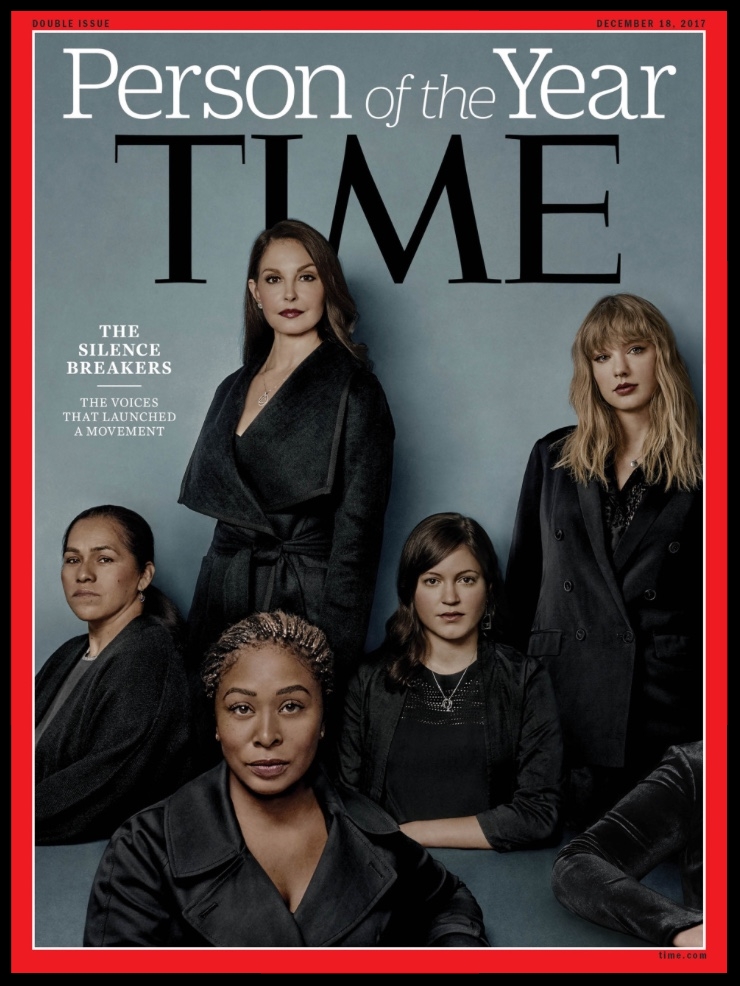"Don’t underestimate me. I know more than I say, think more than I speak & notice more than you realize.” (ironically, unattributed)
The overlooked, the underestimated, the undervalued and the under-represented put their collective feet down this year and said “enough.” From #metoo to Yoyoi Kusama, from podcasts to auction houses, the silent majority is silent no more.
UNDERREPRESENTED NO MORE
In the most well known example, the #metoo movement turned a silent majority into a vocal majority, signaling that women who were once looked over were not going to have their experiences being demeaned overlooked. Time Magazine named “The Silence Breakers” as the Person of the Year 2017, calling attention to the women who created and fueled accountability via the #metoo social phenomenon. In a premature counter-movement--not to be out-done in the minority department--Matt Damon weighed in with his experiences as a non-sexual-harassing unicorn. Perhaps he should have waited a bit with his “whattaboutisms” on white male hardship in the film industry.
OVERLOOKED NO MORE
Malcolm Gladwell, once described as “detective of fads and emerging subcultures and chronicler of jobs-you-never-knew-existed” released his second year of “Revisionist History”, a podcast dedicated to a re-examination of people, events and things that had been overlooked or otherwise misrepresented. Gladwell mines for and then amplifies the worth of these hidden gems in our culture; that they are small or obscure lend an air of gravitas and credibility in a world where Khardashian-type spectacles of celebrity have been the norm. The results? 17,303 reviews where “Revisionist History” averages a 5.0 rating on of 5 point scale.
UNDERVALUED NO MORE
About two years ago, we researched and wrote a piece for our clients on the way in which fitness was moving from a solitary endeavor to a social, entertainment-based activity, and pointed out a number of companies and brands that were well positioned to take advantage of this transformation. As a part of the background work, we dove into businesses like indoor cycling company Peloton, fitness festivals like Wanderlust and smart fabrics and adaptive clothing from the likes of Under Armour, Lululemon and Nike.
In the deep dive into analyst reports and commentary, it stood out that the Lululemon company was getting the short end of the stick. The consensus on the message boards was that Lululemon was doomed because men didn’t like yoga. As the head laundress in our home, I knew from experience that the Lululemon workout gear was high on the usage rotation for my athletically inclined son and his friends. The sweat pants were comfortable, looked presentable enough to wear to class, and the pockets were deep enough for keys and cellphones. In contrast with the expert analysts on message boards, these young men weren’t put off by the stereotypes of the brand as the go-to-attire for warrior-posing women.
The bullying approach of the analysts toward Lululemon seemed unjustified. So, I picked up some stock for my Cultural Foresight portfolio (*) and made 60% on my Lululemon investment in two years. For perspective, the young darling of these same analysts, athleisure brand Under Armour, has since lost 62% of its value in the same time period.
Lululemon Stock (2015-2017) +64%
Under Armour Stock (2015-2017) -62%
(*) This Cultural Foresight portfolio was started in 2014; the funds were my own, but its purpose was to show finance and holding company management at my former agency that understanding and acting upon cultural trends was demonstrably profitable. Thus far, the portfolio is up 64%.
UNDERESTIMATED NO MORE
The art market ebbs and flows in lockstep with the global economy and with global trends (New York Times, October 12, 2017 “Auction Houses Find New Ways to Survive”). To help identify those trends, we took a look at what was selling at three auctions in New York City this fall.
The work of women IS valuable. At the hammer, women’s work delivered the higher prices. In the Contemporary Curated Auction, the average piece by a female artist generated $129,530 compared to the $66,265 average for the work by male artists. In fact, the top three items “at the hammer” were by women: Joan Mitchell “Parasol”, Helen Frankenthaler “Haze” and Yoyoi Kusama “Beyond My Illusion” (left to right). Grandma Moses "Sugaring Off" generated the highest price in the American Art Auction.
This trend continued with the other auctions as well, with work of women artists at the American Art auction generating an average of three times the value of the work by men ($65,331 vs. $20,304 average price at the hammer). Works by women also outpaced those of the male artists at the Contemporary Evening Auction in November, but by a smaller margin, $4.6 million average vs. $4.4 million average.
The work of women HAS been underestimated. While generating slightly higher average prices than the work by male artists, the artwork by female artists in the Contemporary Evening Auction on the block was significantly underestimated vs. the men’s artwork. In this auction, the women’s work sold for 112% more than the high estimate (on average), whereas the work by male artists only exceeded estimate by 22%. The trend of underestimating the work of female artists relative to the male artists was also evident in the other two auctions.
From the social-media fueled #metoo movement to the upper east side Sotheby's gallery, the patterns persist. Those who have been underestimated, undervalued, under-represented or hidden have awoken.
THOUGHT STARTERS:
- A revelatory narrative turns passive listeners into active evangelists. There is an inspirational middle ground between opaqueness and transparency: the narrative impact of revelations that are are both involving and informative move people on a journey of enlightenment about your brand or business that helps bond them to your mission, and make them your brand evangelists;
- Don’t mistake silence for agreement; sometimes silence is an indicator of simmering frustration. More than ever we need to dive deeper than those thin, dime-a-dozen surveys to get real insight. Ways to get beyond the surface: a) hire an experienced moderator instead of sending the summer intern into the field; b) go into homes, communities and workspaces to understand how your brand or service fits in the context of people's real lives; or c) use stimulus to draw out how people feel instead of using stimulus to "qualify" an idea.
- Memories bide their time. People have long memories; when triggered, they produce a rush of emotion that can fuel action. The cascading revelations around Bill Cosby and Harvey Weinstein fueled the #metoo movement that is cleaning out unsavory corners of our culture. On the positive side, every year, the retail businesses do an outstanding job of triggering positive emotions associated with the end-of-the-year holidays. Here's a favorite from 2017.
- Small is the new big; small but well-defined brands are mighty today and with plenty of upside tomorrow;
- Lastly, remember "hell hath no fury like a woman scorned." Matt Damon might have been better received if he had taken the time to reflect upon his own demeaning attitudes and beliefs that were on display in "Project Green Light". Look to categories and brands that have talked down to women or peddled in stoking their fears. These businesses, brands and services are vulnerable now. We can either help challenger brands in countering these approaches or we can help existing brand leaders to forge a redemptive path forward. Both approaches are steps in the right direction.
































































